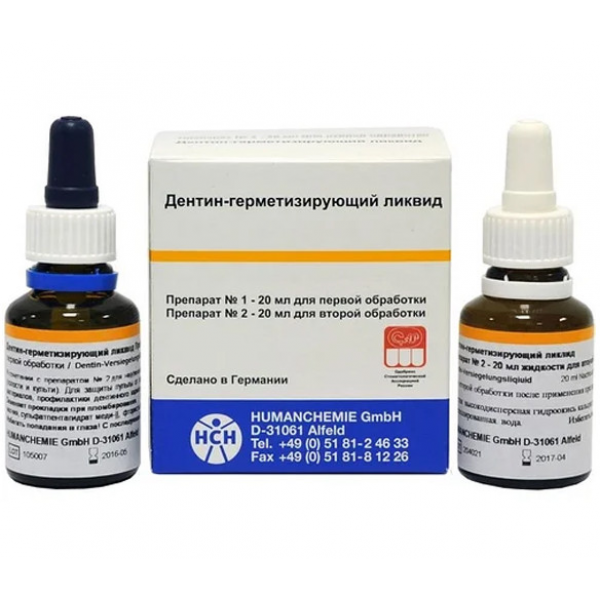Indications for use:
for gaskets with all types of seals, including those made of artificial materials
for the prevention of relapses of caries and secondary caries
Properties: Sealing of the dentin occurs as a result of sequential application of liquids for the first and second quenching. The sealing substance formed as a result of the reaction of these liquids is a high-molecular polymer of silicic acid with submicroscopic crystals of calcium fluoride and copper fluoride deposited in it. .
This substance is alkaline and extremely dense. Reliably protects against all agents, especially acids that are released from cements (including phosphate cement) and have a harmful effect on the pulp.
Thanks to copper ions, the pad has a long-lasting, bactericidal activity that is constantly renewed under the influence of oxygen.
The presence of copper ions, dentine disinfectants, and fluorides provides effective prevention of caries relapses and secondary caries when using any types of fillings, including fillings made of artificial materials (for example, methacrylate-based composites).
Numerous clinical observations indicate that the treatment of cavities with dentin-sealing liquid makes it unnecessary to use other substrates for all filling materials made of artificial materials and provides reliable protection of the pulp.
Application method:
A dry, degreased surface is moistened with a cotton swab soaked in liquid for the first quenching and left for 30 seconds. At the same time, the cavity is dried with warm air.
After 30 seconds, in the same way, the second liquid, which is carefully shaken beforehand, is carried out. After applying the liquid, the cavity is dried with a jet of warm air. This re-quenching is extremely important, as it creates an alkaline environment.
It is recommended to treat deep cavities very close to the pulp in the reverse sequence to prevent too much large-molecular fluoride complex [SiF6] 2- from getting into the pulp. In these cases, they begin with the application of liquid for the second quenching. After drying with air jets, the cavity is moistened with liquid for the first quenching. After drying the cavity, the liquid is again applied for the second quenching.
As a result of such a treatment sequence, the fluoride complex is crushed even before it enters the dentinal tubules as a result of high-polymer silicic acid and sparingly soluble fluorides falling into the sediment.
In the same way, crown stumps are processed (that is, they are first treated with a liquid for the second wetting, and then - for the first).
5 ml / 20 ml of liquid for the first wetting of the surface / the first quenching
5 ml / 20 ml of liquid for the second stewing
100 ml of liquid for the first stewing contains in a stable form: 3.30 g of magnesium fluorine silicate hydrate, 0.78 g of copper sulfate pentahydrate. The composition also includes: 0.1 g of sodium fluoride /as a stabilizer/, distilled water.
100 ml of liquid for the second stewing contain: 10.00 g of highly dispersed calcium hydroxide. The composition also includes: methylcellulose, distilled water.
There are no reviews for this product, be the first to leave your review.

No questions about this product, be the first and ask your question.

